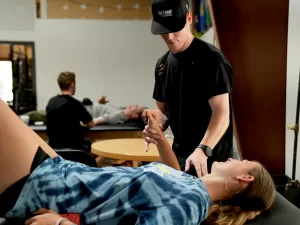 If reaching behind your back has become more difficult — whether to tuck in a shirt, grab a wallet, or adjust clothing — your body may be giving you an early warning. A gradual loss of internal rotation is one of the first indicators that something is off. And while it may start as a small nuisance, ignoring it can lead to bigger problems down the road.
If reaching behind your back has become more difficult — whether to tuck in a shirt, grab a wallet, or adjust clothing — your body may be giving you an early warning. A gradual loss of internal rotation is one of the first indicators that something is off. And while it may start as a small nuisance, ignoring it can lead to bigger problems down the road.
Why That Loss of Motion Matters
When you can’t move freely, your body begins to compensate. These compensations often result in conditions like rotator cuff irritation, impingement, bursitis, or even frozen joints. Many people think they’re simply dealing with pain, especially if they can’t sleep on one side, but restricted movement is often the underlying issue.
Knowing how to help shoulder pain begins with identifying these early mobility changes before they lead to more serious dysfunction.
What You Can Do at Home
There are simple ways to work on mobility at home. Gentle towel stretches or controlled internal rotation drills can be effective — as long as you stay pain-free while doing them. Pay close attention to how the shoulder blade moves, and avoid forcing any position. If improvement doesn’t come quickly, it’s time to get expert help.
Understanding how to help shoulder pain also means knowing when self-care is not enough. Waiting too long may lead to more complex problems that take longer to resolve.
When It’s Time to Call In Support
 Our team is trained to assess the root cause of motion loss and build a plan that restores function — not just masks symptoms. We frequently work with individuals who:
Our team is trained to assess the root cause of motion loss and build a plan that restores function — not just masks symptoms. We frequently work with individuals who:
- Can’t sleep comfortably on one side
- Have difficulty reaching overhead or into cabinets
- Experience discomfort with lifting, pulling, or resistance
- We provide personalized, hands-on care designed to get results — no medications or surgery required.
Let’s Get You Moving Again
You do not have to live with ongoing discomfort or sleepless nights. You also do not need a referral to begin care. If you’re wondering how to help shoulder pain before it gets worse, we’re here to guide you. Contact us today to get started — and get back to doing what you love.
